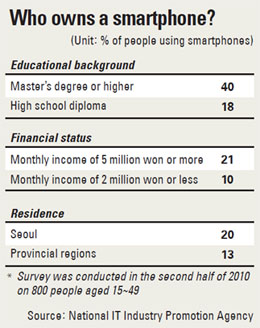Haves and have-nots in the era of smartphones

Think again. The profile of a Korean smartphone owner is someone privileged, well-educated, with a relatively fat paycheck and a residence in Seoul or other metropolitan areas.
A report called “An Analysis of the Socio-demographic Gap in IT Usage in Korea,” released yesterday by the National IT Industry Promotion Agency (NIPA), shows that smartphones are a good measure of the gap in IT accessibility between the haves - in this case, people who have a good educational background and financial status - and the have-nots.
According to a 2010 survey of some 800 people between the ages of 15 and 49, 40 percent of those with a master’s degree or higher said they own a smartphone. That is more than twice the figure for those whose education stopped with high school diplomas.
Bachelor’s degree holders sat somewhere in the middle with 27.2 percent.
In fact, a person’s educational background is an important determinant of how Internet-based his or her life is, and not just on smartphones.
NIPA found that while 63 percent of those with a master’s degree or higher used wireless LAN (local area network) services, while the figure was just 24 percent for those with a high school education.
According to the agency, 21 percent of households with a monthly income of more than 5 million won ($4,600) use smartphones. The figure was just 9.9 percent for those with a monthly income of less than 2 million won.
Despite their popularity, smartphones are an expensive addition to a person’s life. Smartphones are much pricier than conventional cell phones, sometimes up to 400,000 won more, and the monthly bills are much higher too. Some Koreans simply can’t afford them.
That includes rural people. NIPA found that while 20 percent of those residing in Seoul own a smartphone, only 13 percent of those living in provincial regions did.
The report points out the dangers of further social and economic bipolarization as a result of the haves and have-nots situation.
The agency called for the government and industry to provide policy support for “the democratization of smartphones,” a phrase used by some manufacturers and research firms in the mobile industry.
The report said that the gap in smartphone usage “often results from the lack of accessibility or willingness to pay [for it and its services],” adding that in order to narrow the gap “[authorities should] strengthen services and expand investment in infrastructure.”
For instance, one of the reasons cited by people for not using a smartphone was “learning fees,” referring to the costs users have to pay as they learn to use the device. The report suggested mobile carriers and handset makers offer smartphone education.
By Kim Hyung-eun [hkim@joongang.co.kr]
한글 관련 기사 [연합]
스마트폰 신천지, 高소득·학력자들만의 세상
대학원 졸업 이상 스마트폰 이용률 40%..고졸은 18%
월소득 500만원 이상 이용률, 200만원 미만의 2배
학력이나 소득이 높을수록, 서울 등 대도시에 거주할수록 스마트폰 이용률이 높은 것으로 나타났다.
이는 스마트폰이 주도하는 정보화 시대에도 소득과 학력으로 인한 양극화 및 격차가 발생하기 때문으로, 이를 해소하기 위한 정책적 지원이 필요하다는 지적이다.
15일 정보통신산업진흥원이 발간한 `국내 IT 이용에서 인구사회적 격차분석` 보고서에 따르면 세계 최고 수준의 정보기술(IT) 인프라를 가진 국내에서도 성별과 학력, 직업, 거주지 등에 따라 IT 확산과 이용에 있어 차이가 나타나고 있다.
보고서는 한국전자통신연구원이 지난해 하반기 15∼49세 일반인 800명을 대상으로 조사한 자료를 활용했다.
IT 격차를 보여주는 대표적인 품목이 최근 사용자가 1천만명을 넘어설 정도로 급속도록 확산되고 있는 스마트폰이다.
학력별 조사에서 대학원 이상 학력을 가진 이들의 스마트폰 이용률은 10명 중 4명 꼴인 40%로, 고졸 이하(17.9%)에 비해 2배 이상 높았다.
대졸 학력의 스마트폰 이용률은 27.2%로 중간 정도에 위치했다.
이동전화 무선인터넷 이용률에서도 대학원 이상(70.8%)이 가장 높았고, 대졸(66.3%), 고졸 이하(52.4%) 등의 순으로 집계됐다.
무선랜 이용률 역시 대학원 이상(62.5%)이 대졸(33.7%)이나 고졸 이하(23.8%)에 비해 월등히 높았다.
가구소득별로도 스마트폰 이용에 큰 차이를 보였는데, 월평균소득 500만원 이상인 가구의 스마트폰 이용률은 10명 중 2명꼴인 20.7%였다.
그러나 400만원대(16.3%), 300만원대(14.2%), 200만원대(17.8%)는 10%대를 기록했고 특히 월소득 200만원 미만인 가구의 스마트폰 이용률은 9.9%로 500만원 이상 가구의 절반에도 못미쳤다.
거주지역별 분석 결과에서는 서울의 스마트폰 이용률(20%)이 수도권 도시(16.7%)나 광역시(13.7%), 지방도시(13.1%) 보다 높게 나타났고, 거주 형태로는 아파트 거주(17.6%)가 비거주(14.3%)에 비해 높은 것으로 집계됐다.
보고서는 "국내에서는 성별과 연령, 직업, 소득, 거주지역, 거주형태에 따라 IT 이용격차를 보이는 것으로 나타났다"면서 "글로벌 IT 최강국이면서도 내부에서는 인구사회적 특성에 따라 IT 디바이드의 존재를 확인할 수 있다"고 설명했다.
이러한 IT 격차를 축소하기 위해서는 다양하고 차별화된 방향의 정책지원이 필요하다는 지적이다.
예를 들어 스마트폰을 이용하지 않는 이유 중 하나로 학습비용이 꼽히는데, 통신사업자나 단말기 제조업체가 이용교육을 강화하면 이러한 IT 격차를 해소하거나 축소할 수 있다는 것이다.
보고서는 "직업별, 소득별, 거주지역별 격차는 IT에 대한 접근성이나 지불의사 능력의 부족에서 기인하는 경우가 많다"면서 "이러한 격차를 해소하기 위해 보편적 서비스 개념을 강화하거나 인프라 투자 확대를 통해 지역 간 격차를 축소하는 것이 중요하다"고 강조했다.










with the Korea JoongAng Daily
To write comments, please log in to one of the accounts.
Standards Board Policy (0/250자)